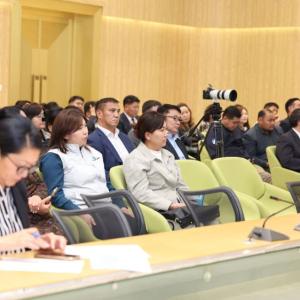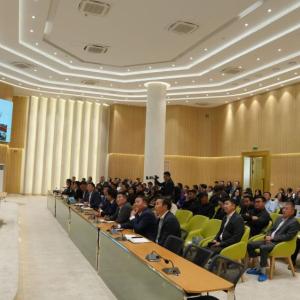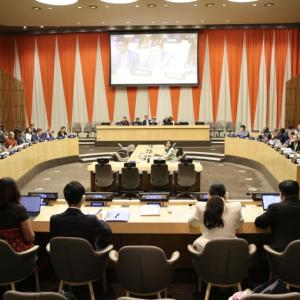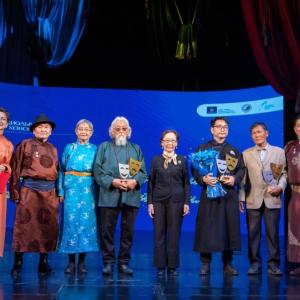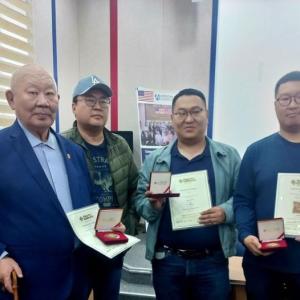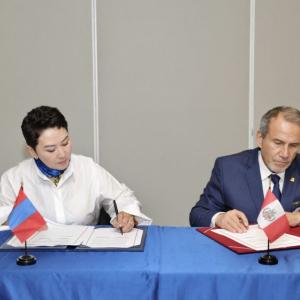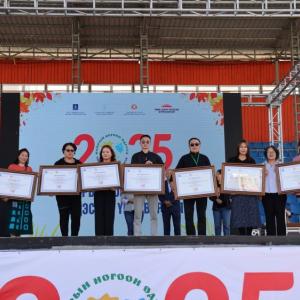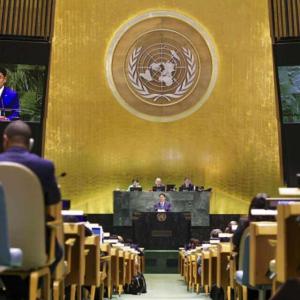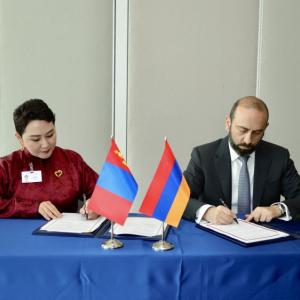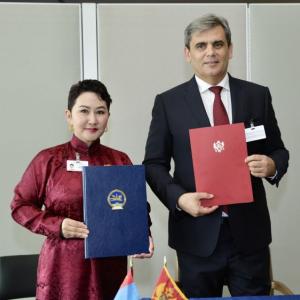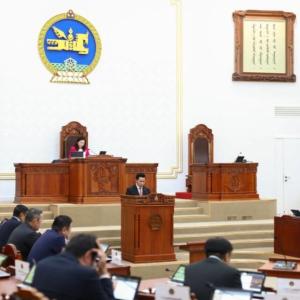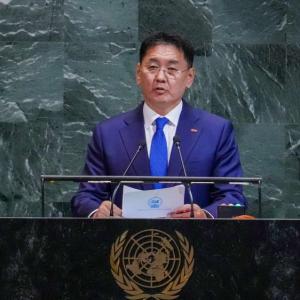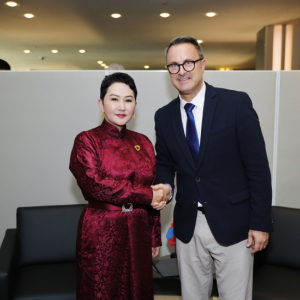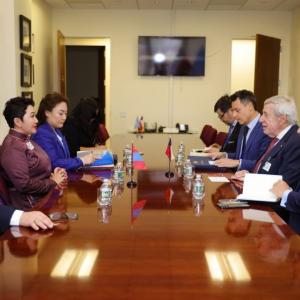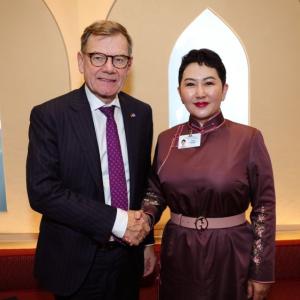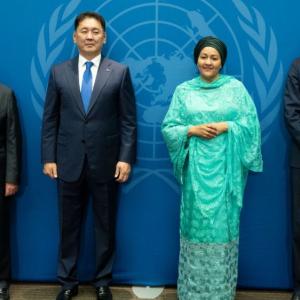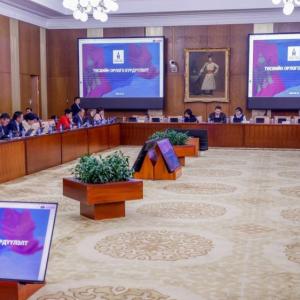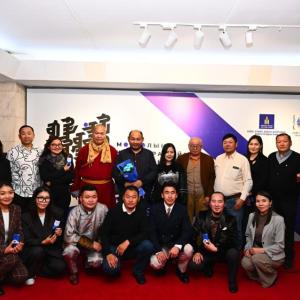The mild melody of B.Munkhbold or fervent energy of his soul
The Mongol Messenger
Ulaanbaatar /MONTSAME/. “My first piano teacher is my brother Munkhbayar. But the person who made me become a composer is my father,” said B.Munkhbold reminiscing. He learned how to play the piano at the age of 5-6 by imitating his brother while he was practicing on the piano. At that time, his brother was studying at the piano class of the Music and Dance College. Elated about the situation, his father was then brought him to the piano class of the school. When his father Birvaa, a famous composer of Mongolia, was working as Head of the Mongolian puppet theatre, he made his son Munkhbold write the music for a scene, “Taimen chasing two small fish to eat”, for the puppet play 'Mundun and Tsundun' by A.Choison.
This was the start of his career as a composer when he was 16. Thinking of the deeds of 'Three musketeers' which he read with much fascination when he was a kid, and seeing how bigger fish in the aquarium were eating the small ones much affected him to write the music for the episode. The painting, 'The Battle of Two Stallions' by Merited Worker of Art of Mongolia O.Tsevegjav is the first painting that B.Munkhbold saw with much admiration. Since then, he has had a deep interest in the painting of natural scenery. 'The Good Soldier Švejk' by Yaroslav Hašek, 'Farewell to Arms' by Ernest Hemingway, 'Sister Carrie' by Theodore Dreiser, 'White Fang' by Jack London, 'The Rage of the Heart' by J.Purev, 'Time of Political Turmoil' by D.Namdag – all the above are the books Munkhbold excitedly read, feeling sympathetic towards the characters and realizing their peeve and pity. Simultaneously, he was deeply in love with the poems, 'The Stand of the Mountain Goat', and 'Gobi' by B.Yavuukhulan, and 'Segs Tsagaan Bogda' by D.Purevdorj. His portraying of these poems in his heart later played a vital role in composing visual music, which can be clearly seen from his talks and music compositions.
“After retiring, my father composed many music compositions for music and drama theatres of 18 aimags. At that time, I did background structure--or phonogram as it is called today. That was how I learned the method to compose visual music. My father Birvaa and my oldest brother Munkhdorj largely supported me in my success today. Coming back to Mongolia shortly after graduating from the conservatoire, I composed the music for the play, 'The Last Night of Socrates' by S.Tsaneev, which my brother Munkhdorj made me do so. He supported me--"a greenhorn with no knowledge" is what he liked to call me back in the day.
Upon getting acquainted with western modernist and postmodernist works, he began composing music in the same movement, and it led to the change in his methods for composition, affecting his emotions to come out spontaneously concerning the tribute to the world view, the faith and mind of every nation. For instance, he composed the music to 'Dead Without Burial', a play by Jean-Paul Sartre. It requires a lot of knowledge and sense to understand the works by Sartre, one of the founding philosophers of the 20th century philosophy, who strongly defended that existentialism is the humanism. In the eyes of the audience, the play's main character is seen as the hero calling for a fight with a gun in his hands, when in actuality it is simply the form. The real heroes are "behind" and there is no main character. It is how Munkhbold understood the motif of the play. Working on the script of the play more and more as his brother working as the stage director made him see many new ideas from the play. Eventually, the “main character” was left solely alive with all the others dead–it is the culmination, and for the audience to understand and to accept it consciously that the music played a key role.
It is very hard to compose the music to the play, 'The Last Night of Socrates', which tells the story about Socrates, the Greek philosopher who lived in 470-399 BC that was accused in front of the Athens court and died by being forced to drink poison. The student who raped the beloved woman of his teacher in front of him, the inexpressibly deep conflict between the teacher and student because of the case, and finally making peace with the student is the impossible conjuncture of mentality which is very hard to express. In this sense, music should play a vital role for the play with profound thinking where there are very few talks and events to be understood. Therefore, the way of western life and the custom of 15th to 17th centuries are expressed with pipe argon. It was very convenient for Christian followers, thus it was very helpful to illustrate people’s mindset of that period. It is his attempt and effort to compose the music reminding of the 16th century alongside simultaneously composing modern classical music.
While getting acquainted with the movements as world classic, avant-garde, modernism, impressionism during the study at the school of music composers in Armenia, Munkhbold participated in a large-scale avant-garde competition announced among composers in the Soviet Union, and took third place with his work contrary to nomadic thinking. At that time, he was just in his 20s.
Due to the ovation of the audience, he felt as if he was on top of the world. However, simultaneously, he felt fear that avant-garde is not the music--though it is the music because of urtyn duu (long song) and nomadic civilization in which he was brought up, the sound and melody which was always singing in his heart seemed to disappear, and composing music is beyond his abilities. “I have regained my melody thanks to long time effort. Since then, I stopped being interested in that style, and now I never want to listen to it,” said Munkhbold reminiscing. His acquaintance and deep understanding of Armenian symphonic work reflecting the life of Armenian people, folk music and songs, musical instruments and dance was the ground to make the work, adequately combining western musical instruments with national musical instruments of Mongolia. An example of this could be his composition of 'Durtmal Saikhan', an urtyn duu as the second piano concert. In this work, he combined symphony orchestra with morin khuur and khuumii (throat singing). Another example is his composition of Kazakh melody for piano, in which he combined classical music ensemble with dombra and iron fiddle. He participated in the Golden Autumn music festival with this work.
“My teacher Alexandr Arutyunyan was a two-time laureate of the State Prize of the Soviet Union and People’s Artist. He could bring the traditional folk music of Armenia to the world stage with his works for the symphony orchestra. It is very similar to that of Rasul Gamzatov who introduced his native small settlement to the world with his work, 'My Dagestan'. My teacher was a composer that was in very high demand, because he always received many requests for composition from countries such as England, France, and Germany. He was truly a world-class composer. My teacher taught me how to compose symphony music. In all the countries of the world, there is no music festival or concourse, in which to play the work for wind instruments by A.Arutyunyan is compulsory,” said Munkhbold.
The key method by B.Munkhbold to create "character" with the music shows the conflict between the outer view of reality and the inner world of imagination. He first thinks about which musical instrument will be played for whom. “Music is the only art which could deeply reach the human heart by illustrating his emotions,” once said by the famous French writer Stendhal. In that case, 'Anu Khatun' symphony by B.Munkhbold is the proof of the above. Although he initially composed the symphony with sorrow of that Mongolian independence was almost lost, people receive the music as the lyrical melody of love, break-up, and sadness and regret. 'Anu Khatun' by B.Munkhbold is the true example of tears flowing inside a broken heart, when coming out as the epic of bravery and courage can be too melodious to feel heart tired. A deep thought freely flowing in the mind and the heart; a feeling of much compassion, and delicate and intricate canto.
It is said that the Mongolian melodious orchestra is according to western music. The music is one of two arts which can be understood without any interpretation. However, the ability to feel it is related to the life the person went through: their knowledge and experience, and their sense to realize. Everyone can listen to music, but music cannot show its riches to everyone. It is important to make effort to feel the music in one’s heart rather than hearing it with one’s ears. The real essence of music can be opened in front of everyone that strives to understand it from the bottom of their heart.
Some melodies of Munkhbold directly reach the heart, but some can be felt after listening to it repeatedly. For example, the music with directly felt melody is the symphony, 'Galdan Boshigt'. In the symphony, the fife plays a unique role to illustrate the courage of the Oirats, who worshipped the magnificent high mountains of Mongolia. It was through this music that he first brought fife into the orchestra by combining it with the symphony orchestra of the State Academic Theatre of Opera and Ballet, which was the first time in history for Mongolian music.
Another
example is the music for the mono opera, 'Heart of the Mother and Letter of the
Son', a new work of his that was introduced right before the New Year. Despite
being a monologue, the disaster of war the mother imagined in her heart, and
her suffering that her son is lost – all illustrated with classic opera
elements through romance, aria, ariosa, singing without utterance, choir, and
dance. In a sense, it is a work in which all of its events are illustrated
through the mother's feeling. Eventually, when the war ends, she receives a
letter from her son saying that he is alive. The letter appeases the heart of
the mother, and with rising to crescendo the opera comes to an end.
The work for which Munkhbold was awarded the State Prize of Mongolia is his Morin khuur concert for the symphonic orchestra, in which morin khuur is combined with the piano. The uniqueness of the work is in classical music expressing Mongolian features by adequately combining Mongolian music composed in sedentary lifestyle with those composed in nomadic lifestyle.
In his works, he uses musical instruments together with various items in nature. One proof of it is in the beginning melody of the dramatic dance 'Mongolian Great Khatuns', with water used in various ways as splattering, beating, and sprinkling. Brief summary of a researcher concerning the dramatic dance is given below.
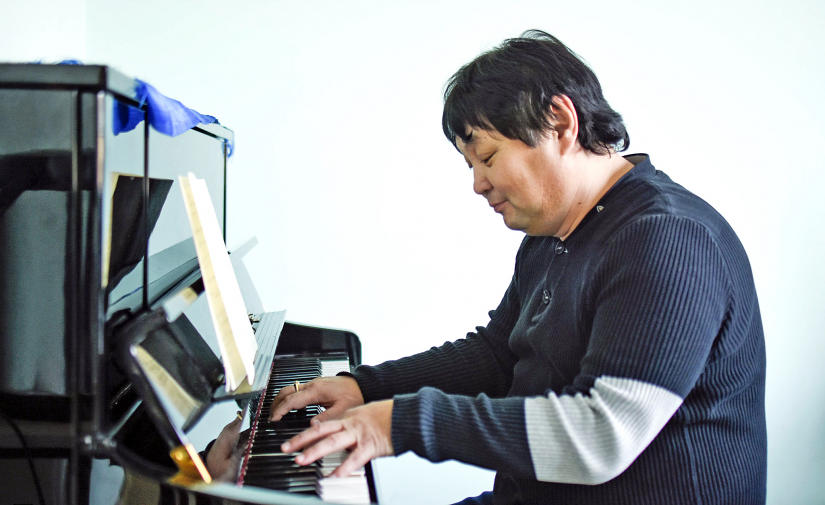
Dramatic Dance 'Mongolian Great Khatuns'
Schpingler has said that “If art becomes one and the same, it will be its downfall. Instead, if it develops while keeping its specific characteristics, it will prosper.” During the modern period of globalization, if all people begin to speak the same language, and create the same work, there will be no difference between one and another. However, artistic creation is the only thing that can preserve the original essence of the nation of Mongolia, interest, and intellectual independence among modern civilizations of mankind.
In her research article, 'Dance of khatuns summoning the ancestral spirits', musicologist, Sc.D L.Erdenechimeg wrote, “Composer B.Munkhbold and choreographer D.Bayarbaatar did not follow twice-told way as TSDT and technique of western music composition in making their structure. Instead, for this work they produced musical imitation and dance movements by combining western and eastern melodies in a very unique way. When working on this dramatic dance, they invented new solution -Т III ҮI DТ for imitation. It is a new imitation and a new tuning which have been seldom used in folk orchestra. In particular, melodies with unique imitation are used in the scenes of Chimbai, her assistant Fatima, Toregene, Sorkhugtani, Burte, and Mandukhai. If considering musical imitation in the view of tonal harmony, there is the prevalence of little three or dissonance, and it is the proof of enriching the design and texture with new technique. Authors aimed to conspicuously illustrate the lives of the nine khatuns, their images and characters as well as their minds with dance movements and music rhythms. The music of this dramatic dance is enriched with new harmony, new composition, and new imitation which has not widely been used in the imitation and composition of the National Academic Ensemble of Song and Dance. In other words, it is very interesting that the music is composed by enriching the methods of western and eastern harmony and imitation with modern imitation. Combination of western and eastern melodies can be seen from the thematic melody for each khatun, rhythm, size, and design, image description, tuning, musical instrument imitation, manner of tuning, illustration of musical utterance, uniqueness of thinking, and the way the musical instruments are played.”
Furthermore, the composer made the ode for 21 religious schools which were restored and renewed by the requisition of the Ministry of Culture of Buriat as well as composing the music to puppet play based on the biography of 'Myal Bogda', and the melody for the mantra of the goddess Yanjinlkham. Munkhbold composing religious music is very understandable as at the ages of 6-12, his father was a disciple at the Lamin Gegeen monastery. In 1998, he composed the first religious symphony, 'Damdin Choijil Dorom', and his grandfather Gonchig who brought religious music into Mongolian music arts was singing 'Marvelous', the ode for Naiman takhil by saying prayers. It may be perhaps due to this that he aims to create great work by studying religious music. Another goal of his is to prepare the young generation of Mongolian composers. In 1984, during his efforts to make the first step towards music composition, he became the student of Ts.Natsagdorj, Laureate of the State Prize of Mongolia. At that time, Ts.Natsagdorj was teaching at the Music and Dance College. In 2004, when teaching at the school, he, together with his teacher, first opened the class of musical composition and composing at the Faculty of Music Theory. Since then, he has been working in charge of the class by continuing the work initiated jointly with his teacher, and have prepared over 10 composers.
Born as the son to G.Birvaa who was the first bugler in Khalkhin Gol, B.Munkhbold grew up by being fed with the great power of the art that enlightens the human soul simultaneously with his mother’s milk. Despite seeming very calm and introverted, he is a composer whose heart is “burning with” energetic melodies. He always repeats to himself the saying by Sophocles, ancient Greek philosopher, “A mathematician becomes a mathematician, a physicist becomes a physicist, but feeling art makes anyone become a human.” He is one of the few talents of Mongolia, an inborn artist dedicating his heart and energy for the art by honoring its value, and has the candor to enlighten mankind and to disseminate the veneration of independence. It is obvious that anyone listening to his works will want to listen to them more and more, thus becoming enlightened and desiring to do good deeds.
Ts.Tumenbayar
Translated
by V.Tsogmaa

 Ulaanbaatar
Ulaanbaatar




